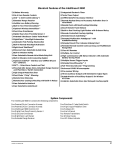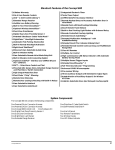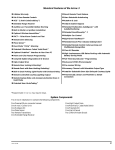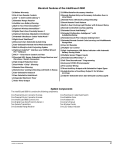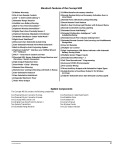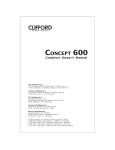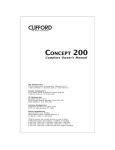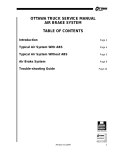Download Clifford Mobile Security/Convenience System With Built-In Remote Engine Starting ACE 7500 User's Manual
Transcript
Downloaded from: http://www.guardianalarms.net Table of Contents Standard Features of the ACE 7500 . . . . . . . . . . . . . . . . . . . . . . . . . 2 Important Information . . . . . . . . . . . . . . . . . . . . . . . . . . . . . . . . 3 Required Installation Tools . . . . . . . . . . . . . . . . . . . . . . . . . . . . . 3 System Components . . . . . . . . . . . . . . . . . . . . . . . . . . . . . . . . . 3 Wiring Diagram - 12-pin Connector . . . . . . . . . . . . . . . . . . . . . . . . . 4 Wiring Diagram - 24-pin Connector . . . . . . . . . . . . . . . . . . . . . . . . . 5 Control Unit and Extended Range Receiver . . . . . . . . . . . . . . . . . . . . . 5 Starter and Ignition Connections . . Immobilization Circuits . . . . . . . . . Starter Connection . . . . . . . . . . . Heater/Air Conditioner Connection . . . Accessory Line Connection . . . . . . . Secondary Ignition or Heater/AC Wire. . . . . . . . . . . . . . . . . . . . . . . . . . . . . . . . . . . . . . . . . . . . . . . . . . . . . . . . . . . . . . . . . . . . . . . . . . . . . . . . . . . . . . . . . . . . . . . . . . . . . . . . . . . . . . . . . . . . . . . . . . . . . . . . . . . . . . . . . . . . . . . . . . . . . . . . . . . . 6 6 6 6 7 7 LED Status Indicator . . . . . . . . . . . . . . . . . . . . . . . . . . . . . . . . . 7 PlainView 2 Coded Valet/Programming Switch . . . . . . . . . . . . . . . . . . . 7 Door Trigger/Interior Light Supply. . . . . . . . . . . . . . . . . . . . . . . . . . 7 Door Locks . . . . . . . . . . . . . . . . . . . . . . . . . . . . . . . . . . . . . 7-8 Parking Lights . . . . . . . . . . . . . . . . . . . . . . . . . . . . . . . . . . . . 9 Factory Theft Deterrent Bypass . . . . . . . . . . . . . . . . . . . . . . . . . . . 10 Reverse Lights . . . . . . . . . . . . . . . . . . . . . . . . . . . . . . . . . . . 10 Brake Lights. . . . . . . . . . . . . . . . . . . . . . . . . . . . . . . . . . . . . 10 Manual Transmission . . . . . . . . . . . . . . . . . . . . . . . . . . . . . . . . 10 Diesel Engine . . . . . . . . . . . . . . . . . . . . . . . . . . . . . . . . . . . . 10 RPM Monitoring. . . . . . . . . . . . . . . . . . . . . . . . . . . . . . . . . . . 11 Trunk Trigger . . . . . . . . . . . . . . . . . . . . . . . . . . . . . . . . . . . . 11 Remotely Adjustable Dual-Zone Piezo Sensor . . . . . . . . . . . . . . . . . . . 12 Glass Tampering Sensor . . . . . . . . . . . . . . . . . . . . . . . . . . . . . . 12 Auxiliary A with Selectable Output Type and AutoActivation . . . . . . . . . . . 12 European Vehicle Window/Sunroof All-Close . . . . . . . . . . . . . . . . . . . . . . . . 12 Hood Trigger . . . . . . . . . . . . . . . . . . . . . . . . . . . . . . . . . . . . 12 High Output Insignia Siren . . . . . . . . . . . . . . . . . . . . . . . . . . . . . 13 Final Wiring Connections . . . . . . . . . . . . . . . . . . . . . . . . . . . . . . 13 SmartPowerUp 2 . . . . . . . . . . . . . . . . . . . . . . . . . . . . . . . . . . 13 Mandatory RPM Programming . . . . . . . . . . . . . . . . . . . . . . . . . . . 13 Delayed Courtesy Lights . . . . . . . . . . . . . . . . . . . . . . . . . . . . . . 13 Remote Control Operation . . . . . . . . . . . . . . . . . . . . . . . . . . . . . 14 Companion & Master Remote Controls. . . . . . . . . . . . . . . . . . . . . . . . . . . 14 Sensor Adjustment . . . . . . . . . . . . . . . . . . . . . . . . . . . . . . . . . 15 Eight-Event TotalRecall . . . . . . . . . . . . . . . . . . . . . . . . . . . . . . . 15 Programmable Features . . . . . . . . Using CliffNet Wizard PRO . . . . . . . . Programming the User-Selectable Features . User-Programmable Features . . . . . . . Installer Programmable Features . . . . . . . . . . . . . . . . . . . . . . . . . . . . . . . . . . . . . . . . . . . . . . . . . . . . . . . . . . . . . . . . . . . . . . . . . . . . . . . . . . . . . . . . . . . . . . . . . . . . . . . . . . . . . . . . . . . . . . . . . . . . 15 15 16 16 17 System Checklist and Troubleshooting . . . . . . . . . . . . . . . . . . . . . 18-22 1 Standard Features of the ACE 7500 o Lifetime Warranty o Eight-Event TotalRecall™ o His & Hers Remote Controls o ACG™ 2 (Anti-CodeGrabbing™) o Prewired LED, Sensor, Extended Range Receiver and PlainView 2 Switch Connectors o Extended Range Receiver o Dual-Mode “Chirp” Silencing o Remote Engine Starting with AutoStart o Remote Siren Silencing o Smart Remote Trunk Release o Works with Automatic or Manual Transmissions o Built-In Dual Parking Light Flasher with Onboard Relay o Works with Diesel or Gas Engines o Audible Low-Battery Warning o Remote-Controlled Courtesy Lighting o Built-In Two-Point Immobilizer™ o Patented Smart AutoTesting™ o Patented PlainView 2 Coded Valet Mode™ o Patented Malfunction AutoBypass™ with AutoReMonitoring o Remotely Adjustable Dual-Zone Piezo Sensor o Patented Smart Prior Intrusion Attempt Alert o Glass Tampering Sensor o Remote Control Code Learning and MultiRemote Recognition o FACT: False Alarm Control and Test o Clear All Remotes o Enhanced User-Selectable AutoArming o Multiple-Car Control o User-Selectable Remote Valet Mode o LED Status Indicator with Automatic Battery-Saving Mode o BlackJax Anti-Carjacking Subsystem o Optional DataPort™ Interface and CliffNet Wizard™ Software o Multiple Sensor/Trigger Inputs o Remote Panic with Smart Locking/Unlocking o Advanced CMOS Microcomputer o Remote Door Locking/Unlocking o One Accessory Channel with Selectable Output Type o User-Selectable AutoLock o Preloomed Wiring o Remote Keyless Entry & Accessory Activation in Valet Mode o Full-Time SecureAccess™ Programming o Integrated Electronic Timer o AutoActivation of Auxiliary Output for Window All-Close on European Vehicles o Patented SmartPowerUp™ 2 o Turbo Timer Output o DataPort Accessory Interface o Installer-Selectable Door Ajar/Delayed Courtesy Lights o High-Output Insignia Siren 2 Important Information 1. DO NOT disconnect the battery cables! Make battery connections by removing the lug nuts from the battery clamps without detaching the clamp itself. 2. Turn off the interior lights or remove the dome light fuse before starting the installation; otherwise, leaving the door(s) open during installation will drain the battery. 3. Use a voltmeter. DO NOT USE A TEST LIGHT! Test lights have a current drain that will damage the vehicle’s onboard computer, and if you probe the wrong wire, could deploy the vehicle’s air bag(s). 4. Make all connections with solder and tape. DO NOT use bite-type connectors. 5. Route the system’s ground and power wires directly to the vehicle battery. 6. Keep extension as short as possible. Use same-gauge wire for short extensions, larger gauge for longer extensions. DO NOT USE SPEAKER WIRE! 7. Discuss placement of the LED, valet switch, window decals, etc. with the vehicle owner prior to installation. 8. DO NOT mount components nor route wires near hot or moving vehicle parts. Clifford components must not impede vehicle servicing or operation. 9. DO NOT mount any Clifford sensor in the engine compartment. 10. Follow the system’s Sequence of Installation to ensure proper installation and testing. 11.Place the owner’s manual in the glove box. Note: Clifford Electronics’ web site for Authorized Clifford Dealers has detailed descriptions of wire colors and locations for most foreign and domestic vehicles. Installation diagrams and programming procedures for older Clifford products are also available. See www.clifforddealers.com (USER NAME=roadshop PASSWORD=cliffg4) for assistance 24-hours per day. Required Installation Tools Voltmeter (set to “DC Volt”) Wire crimper Wire stripper Electric drill and bits Phillips screwdriver Crescent wrench Vinyl tubing Rubber grommet Convoluted tubing Solder gun and solder System Components The ACE 7500 kit contains the following components: One Prewired 24-pin Connector Harness One Extended Range Receiver One Prewired 12-pin Connector Harness One LED Status Indicator One ACE 7500 Control Unit One Owner’s Manual One PlainView 2 Coded Valet Switch One Hardware Kit Two Remote Transmitters Two Window Decals Remotely Adjustable Dual-Zone Piezo Sensor One High Output Insignia Siren One Glass Tampering Sensor 18” CliffNet DataPort Extension Cable 3 Wiring Description for the 12-Pin Connector Pin 1 2 3 4 5 6 7 8 9 10 11 12 Wire Color Red Gray Green/Blue Red Red Brown White/Green Orange Brown White/Blue Not used White/Brown Connects to Battery (+) with 30-amp fuse Heater/AC output Coil side - ignition (+) (and relay shown if manual transmission) Battery (+) with 30-amp fuse Battery (+) with 20-amp fuse Parking light output (+) Key side - starter input (+) Accessory output Parking light output (+) Starter side - starter output (+) Not used Key side - ignition input (+) 4 Control Unit and Extended Range Receiver The ACE 7500 control unit must be installed inside the vehicle, never under the hood or other similarly hostile environment. 1. Select a mounting area, but do not affix the control unit until wiring and testing is complete. 2. Plug the 18” CliffNet DataPort Extension Cable into the control unit. Make sure the receptacle end will be accessible after the dash has been put back. This eases later service. 3. Plug the extended range receiver in to the system and mount it away from the control unit. 4. Run the antenna rod up the window pillar and affix it to the windshield about an inch from the roofline. Do not fold the excess cable or antenna wire. Do not make hard, sharp bends. 5 Wiring Description for the 24-Pin Connector Pin Wire Color 1 2 3 4 5 6 7 8 9 10 11 12 13 14 15 16 17 18 19 20 21 22 23 24 White/Blue White/Violet Black/Gray Blue/Green White Orange White/Black Gray/Yellow Blue/White Black Red Black Gray/Green Green Violet/White Gray/Violet Gray/Orange Red Violet Yellow Blue/Black Brown/Red Gray Blue/Orange Connects to Remotely Adjustable Dual-Zone Piezo Sensor input Pulse out before remote start (-) and upon disarming RPM input Reverse light input (+) Valet switch input (-) Glass Tampering Sensor input (-) Hood trigger input (-) Trunk trigger input (-) Brake light input (+) (and relay shown if manual transmission) Ground for sensors, LED and PlainView 2 Switch Power for Dual-Zone Piezo and Glass Tampering sensors Ground (-) Door lock output (+) or (-) Armed output (-) Pulse out after remote start (-) and upon arming Auxiliary A output (-) Door unlock (+) or (-) Battery (+) with 5-amp fuse LED output (+) Siren (-) Heater 2 relay output if needed (-) Interior light supply input (+) or (-) Door trigger (+) or (-) Negative out when started Starter and Ignition Connections Immobilization Circuits 1. In the underdash ignition switch wireloom, locate the one wire that carries +12V during BOTH the cranking AND engine running cycles, and 0 volts when the ignition is off. You may find two wires in the steering column wireloom that test this way. If so, see the Secondary Ignition or Heater/AC wire section below. 2. Start the engine, then cut the ignition wire. The engine should stop running. 3. Connect the WHITE/BROWN wire to the key side of the ignition line. 4. Connect the GREEN/BLUE wire to the other side. Starter Connection You MUST connect the starter wires before the neutral safety switch, otherwise the engine could be started while in gear. Be certain that both the WHITE/GREEN and WHITE/BLUE wires are solidly connected. 1. Use a voltmeter to locate the one wire that carries +12V during the cranking cycle ONLY. Cut this wire, then try to start the engine. It should not crank. 2. Connect the WHITE/GREEN of the ACE 7500 wire to the key side of the cut starter line. 3. Connect the WHITE/BLUE wire of the ACE 7500 starter side of the cut starter line. Heater/Air Conditioner Connection 1. Turn the vehicle’s heater/AC switch on and rotate the ignition key toward START one increment at a time. Observe at which position the blower turns on. 2. Turn the engine OFF. 3. Connect the voltmeter black lead to ground and set the dial to DC volt. 4. Locate the one wire that carries +12V only when the ignition key is at the position where the blower activates. 5. Cut the wire , then start the engine. The blower should not operate. 6. Connect the 12-pin connector’s GRAY wire to the heater/AC wire as shown on page 4. 6 Accessory Line Connection Most vehicles have a separate accessory line to power the radio, electric windows, etc. 1. Turn on the vehicle’s radio and rotate the ignition key to ACC. The radio should turn on. 2. Locate the one wire that carries +12V only when the ignition key is in the ACC and ON positions, but 0V while the key is in the START position. 3. Cut this wire, then start the engine. The radio should not operate. 4. Connect the 12-pin connector’s ORANGE wire to the accessory wire as shown on page 4. Secondary Ignition or Heater/AC Wire Many vehicles have two ignition or two heater/AC wires in order to split up the power requirements of the temperature control system, onboard computers, fuel delivery system, electronic transmission control, etc. If you are working on such a vehicle, you will find two wires that both test as ignition lines or two wires that supply the heater/AC: 1. Connect the BLUE/BLACK wire to the coil of a relay for the second heater/AC line. 2. Connect the BLUE/ORANGE wire to the coil of a relay for the 2nd ignition line. LED Status Indicator Select a prominent location on the dash or console. Discuss placement with the owner. 1. Verify there is adequate space to accommodate the LED, then drill a 5/16” (8mm) hole and route the wires through it. 2. Mate the LED connectors to the VIOLET and BLACK wire connectors as shown in the diagram on page 5. 3. Press the LED into place. PlainView 2 Coded Valet/Programming Switch 1. Discuss placement of the switch with the vehicle owner and avoid placing the switch where it can be pressed accidentally. 2. Verify there is adequate space behind the selected location to accommodate the switch. 3. Drill a 5/16” (8mm) mounting hole, then insert the wires through the hole. 4. Mate the switch’s locking connectors to the WHITE and BLACK locking connector. 5. Remove the adhesive backing and press the switch into place. Door Trigger/Interior Light Supply The ACE 7500 has self-programming door trigger polarity. Door triggers on most autos are negative (except most Rolls-Royce and Ford autos). To determine door trigger polarity, use the following procedure: 1. Find the wire coming off the rear of the vehicle door switch. 2. Connect the negative voltmeter lead to ground. 3. Find the one wire that shows +12 volts when the switch is pressed in and 0 volts when released. This is a negative trigger door wire. 4. If you don’t get the indications noted in step 3, find the one wire that shows 0 volts when the switch is pressed in and +12 volts when released. This is a positive trigger door wire. 5. Connect the system’s thin GRAY wire to the door wire. 6. If the trigger wire is negative, connect the system’s BROWN/RED interior light supply wire to ground. If the trigger wire is positive, connect the system’s BROWN/RED interior light supply wire to the RED/WHITE wire. NOTE: Clifford Electronics’ web site at www.clifforddealers.com (USER NAME = roadshop PASSWORD = cliffg4) for Authorized Clifford Dealers has detailed descriptions of wire colors and locations for most foreign and domestic vehicles. Installation diagrams and programming procedures for older Clifford products are also available. You can also obtain this information via the Clifford Technical Support Computer Database or via our toll-free AutoFax or our exclusive Circuit City Technical Support Hotline at 1-877-CLIFF-G4. 7 Door Locks WARNING: If the power door locks do not operate properly when the system is armed and disarmed, DO NOT USE THE VEHICLE’S DOOR LOCK SWITCH! Permanent damage to the control unit or to the car’s electrical system and lock servos will result. For assistance, call the Clifford Technical Support Hotline PRIOR to wiring the door locks. The ACE 7500 provides power door lock interface capabilities and is able to interface with any power door lock configuration including some Mercedes Benz and Audi vehicles that require a 3-second lock pulse (pulse duration is installer-programmable) and with any car that requires double unlock pulsing (VW’s and Nissans, for example). If the vehicle is not equipped with power door locks, you may optionally add up to four #60-516 Door Lock Servos to provide all the keyless entry and other door locking/unlocking features built into the ACE 7500. Some cars may require adding relays. Determining the Lock System Type 1. Remove the door lock switch on the driver’s side of the vehicle to reveal the switch wires. a. If there are four or more wires, make the connections shown in Diagram 4 for reverse polarity. b. If there are three wires, proceed to step 2. c. If the vehicle is a Nissan and it does not have a door lock switch, find the single wire in the driver’s kick panel that shows ground when the locks are unlocked and “open” when the locks are locked. Cut this wire and make the connections shown in Door Lock/Unlock Diagram 3. 2. Connect the negative voltmeter lead to ground and probe each wire while locking/unlocking. If the voltmeter show +12v while activating the switch, make the connections shown in Door Lock/Unlock Diagram 1 for positive trigger. Otherwise, go to step 3. 3. Repeat step 2 with the negative voltmeter lead connected to +12v. If the voltmeter shows +12v while activating the switch, make the connections shown in Door Lock/Unlock Diagram 2 for negative trigger. 4. Locks controlled from the driver’s door key require installation of just one #60-516 servo in the driver’s door. Vehicles without factory power locks require a servo in each door. Mount the servo(s) and make the connections shown in Door Lock/Unlock Diagram 5 for adding servos. 5. On a vacuum-pump-type Mercedes Benz or Audi, make the connections shown in Door Lock/Unlock Diagram 6, then (if 1989 or older) program the system for a 3-second lock pulse. 8 6. The ACE 7500 can also provide double pulses (+ or -) for lock and/or (+ or -) unlock that is required by some vehicles (such as some Nissans, VWs, and Audis). Wire the door locks following the steps above and select the 2x lock and/or unlock feature in installer-programming. Parking Lights The ACE 7500 has built-in parking light relays. To determine whether the vehicle has single or dual parking light circuit(s), you must access the fuse panel. A single circuit has one fuse; a dual circuit has two. Single Parking Light Circuit (Most Japanese and American Vehicles) 1. Turn on the parking lights and access the Parking Light wiring in one of the following locations: nNear the headlight switch nIn the door sill harness going to the rear lights nAt any of the four Parking Light bulbs 2. If working underdash, be sure to turn the dashlight dimmer to its lowest setting. 3. Connect a voltmeter lead to ground and find the single wire that shows +12v when the parking lights are on and 0 volts when they are off. 4. Connect both of the BROWN wires to the parking light wires. 5. Connect the RED 18AWG wire from the 12-pin connector to the vehicle battery positive (+) terminal via the supplied 20-amp fuse and fuseholder. Dual Parking Light Circuit (Most European Vehicles) 1. Turn on the parking lights and access the Parking Light wiring in one of the following locations: nNear the headlight switch nIn the door sill harness going to the rear lights nAt any of the four Parking Light bulbs 2. If working underdash, be sure to turn the dashlight dimmer to its lowest setting. 3. Connect a voltmeter lead to ground and find the two wires that show +12v when the parking lights are on and 0 volts when they are off. 4. Connect one lead to the left-side Parking Light circuit and connect the other lead to the right side circuit. 5. Connect the RED 18AWG wire from the 12-pin connector to the vehicle battery positive (+) terminal via the supplied 20-amp fuse and fuseholder. NOTE: Never connect the RED 18AWG wire to ground. Always pick up the positive-switching parking light line(s). 9 Factory Theft Deterrent Bypass The wiring noted below is to disarm a vehicle’s factory system to permit remote starting. For more information on factory theft deterrent bypass, check your Clifford Tech Support Database, visit www.clifforddealer.com (USER NAME = roadshop PASSWORD = cliffg4) or call our toll-free Circuit City Technical Support Hotline or AutoFax at 1-877-CLIFF-G4. 1. The BLUE/ORANGE wire is a negative out whenever the vehicle is remotely started. It can be used for extra ignition relays or for factory alarm bypass. 2. The WHITE/VIOLET wire is a negative pulse out just prior to remote engine starting. It can be used to pulse a factory disarm wire or unlock the doors. This wire also pulses when the ACE 7500 is disarmed using the remote. 3. The VIOLET/WHITE wire is a negative pulse out after remote engine starting. This can be used to lock the doors after remote starting if the doors had been unlocked prior to starting. This wire also pulses when the ACE 7500 is armed using the remote. Reverse Lights 1. Verify that the reverse lights illuminate when the transmission is put in reverse. 2. Find the one wire in the kick panel that reads +12V only when the transmission is in reverse. 3. Connect the BLUE/GREEN wire to the reverse light as shown on page 5. Brake Lights If working on a manual transmission vehicle, add a 3-amp diode terminal 30 of an optional relay as shown on pages 4-5 and connect it into the BLUE/WHITE brake input wire. See also Manual Transmission section below. 1. Turn the ignition ON and press the brake pedal to make sure the brake light turns on. 2. Connect the black lead of the voltmeter to ground and set the dial to DC volt. 3. Probe one of the two wires at the brake pedal switch with the voltmeter red lead. The voltmeter should read +12V when you press the brake pedal; 0 volts when released. 4. Connect the BLUE/WHITE wire to the brake light wire as shown on page 5. Manual Transmission 1. Find two wires going in to a connector on the clutch pedal. 2. Unplug the clutch pedal connector, then try to start the vehicle while pressing the clutch pedal. The engine should neither start nor crank. 3. Connect the BLUE/ORANGE wire to an optional relay as shown. 4. Turn on the ignition. 5. Find the one wire near the emergency brake that carries +12V when the emergency brake is engaged and 0V when it is disengaged. 6. Connect the emergency brake wire to terminal 86 of a relay as shown on pages 4-5. Diesel Engine Use the built-in timer to crank the engine 20 seconds after the remote start command is received. Using the 20 second delay: Using the Installer-Programming instructions on page 17, set column 2, row 5 to “Diesel Engine,” then immediately program RPMs, or use the CliffNet Wizard Pro installation software to program the system. The CliffNet Wizard PRO will also allow you to customize the delay to other than 20 seconds. 10 RPM Monitoring The ACE 7500 monitors RPM which is REQUIRED for the operation of the remote engine starting electronics as well as the anti-carjacking electronics and RPM-dependent AutoLock feature. After powering up the system, you must perform the MANDATORY RPM PROGRAMMING noted on page 13. Some newer vehicles do not have a conventional coil marked (+) and (–). In these instances, you will need to locate the tach wire: 1. Try to locate the distributor cap which all spark plug wires run in to. There should be the same number of plug wires as the number of cylinders. If there is an extra plug wire, the vehicle has a separate coil. 2. Follow the extra plug wire to the coil module, which will have two or more wires. a. If there are only two wires: one is the ignition, the other wire is the negative coil wire. b. If there are more than two wires, only an oscilloscope will be 100% accurate in locating the tach wire, but a digital voltmeter will often suffice. Set the meter to read AC voltage, connect the negative lead of the meter to ground and probe the wire with the positive lead. The wire that has the highest AC voltage while the engine is running is usually the tach wire. 3. If the vehicle does not have a separate coil, look for the tach wire in a plug coming out of the distributor. If no distributor can be found, there may be multiple coils. Each coil usually has an ignition and a negative coil wire. The system will learn a single or multiple coil system. 4. If no coil or distributor can be found or reached, use the #60-226 RPM Alternator Sensor. 5. You can often connect to the negative side of any fuel injector. Most injectors are screwed directly into the engine and have two wires. One is ignition and usually has a color common to all, the other is the negative side and can be tested as described in step 2b above. Installation Options 1. Installation Option 1 — Negative Coil Connect the BLACK/GRAY wire to the negative terminal of the ignition coil, normally marked (–). 2. Installation Option 2 — Fuel Injector Wire a. On many engines with electronic fuel injection, there are two wires going to each injector: a fuel-injector wire and a common ignition wire. The common ignition wire is usually the same color at each injector (and may also be the same color as the ignition line in the steering column). The injector wire is the other wire. b. Connect the BLACK/GRAY wire to one of the injector wires. 3. Installation Option 3 — Tachometer Terminal (Not all cars have a tachometer terminal — mostly older GM models have a tachometer terminal) a. Locate the tachometer terminal on the distributor cap (this may be marked “tach”). b. Connect the BLACK/GRAY wire to the tachometer terminal. 4. Installation Option 4 — Optional Alternator Sensor (#60-226) Follow the instructions provided in the Alternator Sensor kit. 5. Installation Option 5 — Optional RPM Monitoring Module (#60-521) a. Locate the coil wire that connects to the distributor. b. Attach the RPM Monitoring Module to the coil wire. c. Connect the RED, BLACK and WHITE wires on the RPM Monitoring Module to the RED, BLACK and BLACK/GRAY wires of the system. Trunk Trigger Vehicles with a ground-switching trunk light will interface directly with the ACE 7500 (on positive switching Rolls-Royce vehicles, use a relay to invert polarity). The switch may be located in or near the trunk latch or at the trunk light. If a switch cannot be located, you must add a pin switch in a location away from water channels. NOTE: If the vehicle has a dashboard trunk ajar indicator, install a 1-amp diode between the light and switch with the diode band toward the switch. 1. Connect the GRAY/YELLOW wire to the trunk switch (between the diode and switch). 11 Remotely Adjustable Dual-Zone Piezo Sensor Mount this sensor in the passenger compartment, not in the engine compartment. 1. Firmly mount the sensor near the base of the steering column (if the steering column has a rotating sleeve, firmly screw the sensor to the interior firewall, kick panel or trunk wall). 2. Mate the sensor to the connector with the BLACK, RED, and WHITE/BLUE wires. 3. After power-up, adjust the sensor as noted on page 15. Glass Tampering Sensor Mount this sensor in the passenger compartment, not the engine compartment. 1. Mount the microphone holder so that it points into the passenger compartment, but will not be exposed to direct sunlight. 2. Plug the microphone into the sensor (an optional second microphone can be added for vans and other large vehicles for increased sensitivity and better discrimination). 3. Mate the sensor to the connector with the BLACK, RED and ORANGE wires. Auxiliary A with Selectable Output Type with AutoActivation The Auxiliary A output (GRAY/VIOLET wire) can be programmed as either pulsed, latched or timed and can be programmed to operate only when the system is disarmed (e.g., for use as a remote trunk release). Note that the selectable output type is only programmable using the CliffNet Wizard Pro. Auxiliary A output is activated by pressing the button on the companion remote control or button 2 on the master remote control. The factory setting is pulsed output (1 second ground). The latched output stays at ground until the button or button 2 is pressed a second time, and the timed output stays at ground for any selected duration between one second and four minutes. Current is limited to 0.15 amp. You can also set this output to automatically activate every time the system is remotely-armed (perfect if wiring as a timed output to close the electric windows and sunroof on European vehicles that have an all-close feature). See Installer-Programmable Features on page 17 to change the type of output, set AutoActivation and/or disable operation while the system is armed. European Vehicle Window/Sunroof All-Close If the door key can close the power windows/sunroof, you can make them automatically close upon remote arming (CliffNet Wizard is required to program this feature): 1. Find the wire that shows +12V or ground when the key is held to lock in the door cylinder. 2. Tap a wire in to this wire and connect to terminal 30 of the relay. 3. If the wire shows (-) when the key is turned, connect terminal 87 to (-). If the wire shows +12V when the key is turned, connect terminal 87 to 12V. 4. Connect the output of the alarm that can be set to AutoActivate to terminal 85. 5. Connect +12V to terminal 86. 8. Turn on the AutoActivate timed accessory upon remote arming feature as noted in the installation manual for the alarm under Installer-Programmable Features. 8. Set the timer duration to proper time interval with two seconds added to that time interval.Engine Bay Connections. 9. Set Auxiliary Output A to Timer using the CliffNet Wizard. Engine Compartment Connections Hood Trigger Vehicles with a ground-switching hood pin switch interface directly with ACE 7500 (on positive switching Rolls-Royce vehicles, use a relay to invert polarity). If a switch cannot be located, you must add a pin switch in a location away from water channels. 1. Connect the WHITE/BLACK wire to the hood pin wire. 12 High Output Insignia Siren Mount the siren in the engine compartment away from hot or moving parts and where it cannot be reached from under the vehicle, preferable opposite the exhaust system. Point the siren down to avoid water collection (see the illustration). 1. You must firmly secure the siren to the engine bay firewall or a fender well using all three sheet metal screws supplied. 2. Using the supplied connector, fasten the BLACK wire coming from the siren to the YELLOW wire from the 24-pin connector on the control unit. 3. Connect the RED wire to the 5-amp fuse that is connected to the battery positive cable clamp. Final Wiring Connections 1. Connect the two 14AWG RED wires from the 12-pin connector to the 30-amp fuseholders as shown on page 4. 2. Connect the 16AWG RED wire from the 12-pin connector to the 20-amp fuseholder. 3. Connect the 18AWG RED wire from the 24-pin connector to the 5-amp fuseholder. 4. Attach the four fuseholders to the battery positive cable clamp. 5. Attach the 18AWG BLACK wire from the 24-pin connector to the battery negative cable clamp. NOTE: Power and test accessories after the basic system has been tested. Individually fuse all accessory power and fuse panel connections. SmartPowerUp™ 2 SmartPowerUp 2 ensures that the system powers up in the same state (disarmed, armed or valet mode) it was in when power was removed. When you first power up the ACE 7500, it will silently enter the disarmed state. MANDATORY RPM PROGRAMMING NOTE: ACE 7500 will not operate properly without this programming step. NOTE: If working on a diesel engine vehicle, you must first set the system for diesel operation using the Installer-Programmable Features on pages 17-18. 1. Drive the vehicle outside the RoadShop bay and allow the engine to warm up. 2. With the engine still running and the transmission in PARK or NEUTRAL, enter the valet code (✱✱ blank) on the PlainView 2 switch and immediately hold the ✱ button. You’ll hear one chirp to indicate user programming mode. 3. KEEP HOLDING (about 12 more seconds) until you hear the 3-chirp installer programming mode confirmation. 4. Select “Program RPM”: Press the PlainView switch blank button once, wait for 1 chirp, then ✱ 5 times and wait for the 2 chirps to confirm that the RPMs have been set (if you hear one chirp instead, check connection of the BLACK/GRAY wire). 5. If working on an automatic transmission vehicle, you must also set the transmission type to automatic. See Installer-Programmable Features on pages 17-18. 6. Turn the ignition off to exit installer program mode. Delayed Courtesy Lights Some vehicles have a courtesy light delay or dimming circuit that interferes with an alarm being able to detect the door trigger upon remote arming. If the delay or dimming lasts more than 5 seconds, turn on the Delayed Courtesy Lights feature noted in the Installer-Programmable Features section on page 17. Please note that since this feature sets the system to arm the instant the courtesy lights turn off, the Door Ajar Warning feature will not be available. 13 Remote Control Operation The ACE 7500 comes with two ergonomically designed remote controls. Up to two more ACG 2 remote controls can be added to the ACE 7500 system (older Clifford ACG and non-ACG remotes are not compatible with the ACE 7500). If a remote control is ever lost or stolen, its identity can be erased from the system memory so that the missing remote control can never again be used to control the system. To do so, just use the Clear All Remotes feature noted in the User-Programmable Features chart (blank x 2, ✱ x 6)on page 16. Companion & Master Remote Controls The icon buttons on the companion remote control operate arming/disarming (the lock/unlock button), the auxiliary output (the trunk button), remote engine starting (the snowflake button) and the AutoStart/Manual Transmission SafeStart mode (the double snowflake button). In addition, other system features can be accessed by pressing combinations of these buttons. For example, to silently arm or disarm, simultaneously press the ✱ and the button. The master remote control can operate higher level functions, such as sensor adjustment, by shifting the 4 buttons up to a higher level via the LevelShift button on the side of the remote control. For example, to access the sensor adjustment mode (described on the following page), you would press the side LevelShift button 3 times, then press button 3. QUICK REFERENCE: REMOTE CONTROL FUNCTIONS Companion Remote Button(s) Function Master Remote LevelShift Button Arm or disarm and lock or unlock the doors no 1 Optional wired accessory #1* (usually optional trunk release) no 2 Silently arm or disarm and lock or unlock the doors no 3 no 4 1 time 1 1 time 2 1 time 3 1 time 4 2 times 1 2 times 2 2 times 3 + ✱ ✱ Remotely start the engine Unassigned* + Unassigned or SmartWindows 4 accessory full open or vent* Unassigned* ✱ + + ✱✱ Unassigned* Remote valet mode entry/exit Unassigned* LowTemp/Battery AutoStart or manual transmission SafeStart ✱✱ + ✱ ✱✱ + ✱✱ Unassigned* 2 times 4 Unassigned* 3 times 1 Unassigned* 3 times 2 Remotely adjust sensitivity of the Dual-Zone Piezo Sensor 3 times 3 Unassigned* 3 times 4 *These buttons/channels can be assigned to control Clifford G4 systems and accessories on the customer’s other vehicles. 14 Sensor Adjustment 1. Disarm the system with the master remote control. 2. On the master remote, press the LevelShift three times, then button 3. You will hear one chirp and the LED will turn on. 3. Test the primary (alarm) zone, by firmly “thumping” the top of the A-pillar (the area between the side windows near the roof) with the heel of your fist. If the impact is strong enough to trigger the primary zone, you will hear a siren chirp. To change sensitivity, press button 4 to reduce sensitivity, button 2 to increase sensitivity. Two chirps will acknowledge each sensitivity increase, one chirp will confirm each decrease. You can test the new setting by again thumping the top of the A-pillar. You may now press button 3 to adjust the warning zone (as noted in 3a. below), or press button 1 to fully exit the sensor adjustment mode (you will hear 3 chirps). a. For the Piezo Sensor warning zone, press button 3 (you’ll hear 1 chirp). Then use the same procedure as above, but thump less forcefully for the warning zone. When done, press button 1 to reselect the primary zone (you will hear 2 chirps), then button 1 again to fully exit sensor adjustment mode (you will hear 3 chirps). 4. For the Glass Tampering Sensor, a light tap on the window with a coin should not trip the system, but a firm tap should. 5. Turn the Glass Tampering Sensor’s adjustment screw counterclockwise to decrease sensitivity, clockwise to increase (you may also reposition the sensor’s microphone[s]). Eight-Event TotalRecall The system’s nonvolatile memory records the identity of the last eight activated or malfunctioning triggers and sensors: 1. With the ignition OFF, press and hold the blank side of the PlainView 2 Switch. 2. Use the remote control arm, and then again to disarm, and then release the button. 3. The LED will flash 1–10 times, pause, then flash 1–10 times, etc. Write down the number of flashes in each cycle. 4. Refer to the following chart. The first number you wrote down was the most recently activated trigger or sensor. The next number is the second most recent, and so on up to as many as the last eight activations. LED flashes Trigger/sensor indication 2 flashes Dual-Zone Piezo Sensor 3 flashes Glass Tampering Sensor 4 flashes Door trigger 5 flashes Trunk trigger 6 flashes Hood trigger 7 flashes An attempt was made to turn on the ignition while the system was armed 9 flashes BlackJax activation 10 flashes System power interruption Programmable Features ACE 7500 comes from the factory with its features preprogrammed as noted in bold text in the tables on pages 16 and 17. Using the CliffNet Wizard PRO CliffNet Wizard PRO provides an intuitive access to all installer and user-programmable features through a user-friendly, graphical user interface and provides extensive diagnostic capabilities. See www.clifforddealer.com (USER NAME = roadshop PASSWORD = cliffg4) to download a free copy of the program. 15 Programming the User-Selectable Features 1. Write down the column (across) number and row (down) number of the feature(s) you wish to program. 2. Turn the ignition to the “ON” position or start the engine. 3. Enter the factory preset valet/programming code of “2” by pressing the PlainView 2 Switch’s ✱ button two times, then press the blank button. 4. After entering the code, press and hold the ✱ for about 3 seconds until you hear one siren chirp and the LED turns on to confirm the system is in the “Feature Select” position. 5. Select the feature column: Press the blank PlainView 2 switch button the number of times indicated for that column. Pause. You will then hear the same number of chirps as the column number you have selected, audibly confirming your selection. 6. Within five seconds, select the feature row: Press the ✱ button the number of times indicated for that row. You’ll hear a chirp each time you press the ✱ button to help you count. 7. If there is a NOTE for the selected feature, perform the actions noted. 8. Pause. You will hear either one or two chirps: two chirps = ON, one chirp = OFF. 9. You can select another feature, or you can exit program mode: a. To select another feature in that same column, repeat step 6 within the next five seconds (after five seconds, three chirps indicate that the ACE 7500 is now back in the “Feature Select” position). b. To select a different feature column, repeat step 5. c. To exit program mode, turn the ignition off (you’ll hear three chirps and the LED will turn off to indicate exit of program mode), or wait 60 seconds and the ACE 7500 will automatically exit program mode. User-Programmable Features User-Programmable Features (1 Chirp = OFF, 2 Chirps = ON) Feature Select Blank x 1 Blank x 2 Blank x 3 Blank x 4 ✱x1 AutoProgram New Master Remote NOTE 1 Chirps (Off/On) (1/2 chirps) AutoArming (Off/On) (1 chirp/2 chirps) Arm/Disarm w/Secondary Remote NOTE 5 ✱x2 NOT USED Headlight Reminder (Off/On) AutoArm & Lock (Off/On) Auxiliary A Accessory w/Secondary Remote NOTE 6 ✱x3 Siren Sounds* (Always/Trigger) (1/2chirps) Remote Valet Feature (Off/On) Entry Delay (Off/On) Silent Arm/Disarm w/Secondary Remote NOTE 6 ✱x4 Siren Duration (30/60/90 sec) (1/2/3 chirps) AutoStart (Neither/Battery/ Temperature/Both) (1/2/3/4 chirps) FACT (Off/On) Manual Start Enable w/Secondary Remote NOTE 6 ✱x5 AutoLock (Off/Instant/RPM) (1/2/3 chirps) BlackJax (Off/On) Delayed Accessory Power (Off/On) Remote Start w/Secondary Remote NOTE 6 ✱x6 AutoUnlock (Off/On) Clear All Remotes NOTE 3 NOT USED SmartWindows 4 w/Secondary Remote NOTE 6 ✱x7 Reset All to Factory Settings NOTE 2 Valet Code NOTE 4 NOT USED Remote Valet Mode w/Secondary Remote NOTE 6 *Requires Self-Powered SmartSiren 4 16 n NOTE 1: Press button 1 on the 16-channel master remote, you will hear one chirp. Press button 1 again, you will hear two chirps. n NOTE 2: You will hear two chirps when all features are reset. Valet code and remote controls are not changed. n NOTE 3: When you hear two chirps, all remote controls will have been erased from the system memory. You must now add the new and/or existing remote controls to the system (i.e., Program each remote that will be used with the ACE 7500). n NOTE 4: Immediately press the blank button, then immediately enter the new PIN code. (Example: To enter 4301, you would press: ✱✱✱✱ blank, ✱✱✱ blank, blank, ✱ blank.) Wait for the 2-chirps, then turn off the ignition (3-chirps). IMPORTANT: You must immediately test the new PIN code: Turn on the ignition, enter the new code, then press and hold the blank button for 4 seconds. The LED will light to indicate that the system is in valet mode, enter the code again to exit valet mode. If the LED does not illuminate, the new code you programmed and the one you just entered do not match. In such a case, the system will revert to the previous code. n NOTE 5: Programs a companion remote or any other type remote from another G4 system to arm/disarm this system. For instance, to set button ✱ of the other car’s remote to arm/disarm this system, select column 4, row 1, then press button ✱ of the other car’s remote. You’ll hear 1 chirp. Immediately press button ✱ of the other car’s remote again. You’ll hear 2 chirps. n NOTE 6: Programs a companion remote or any other type remote from another G4 system to perform the noted function on this system. Select the row and column number, then transmit the unused button/channel on the other remote that you want to perform that function. The system will respond with the same number of chirps as the row number. Please note that you must first set a button on the remote that will arm/disarm the system (column 4, row 1) before these others will be accepted. Installer-Programmable Features To access the installer-programmable features: 1. Turn on the ignition. 2. Enter the valet code (✱✱ blank) on the PlainView 2 switch and immediately hold the ✱ button on the PlainView 2 switch. 3. You’ll hear one chirp after about 3 seconds to indicate user programming mode. KEEP HOLDING (about 12 more seconds) until you hear the 3-chirp installer programming mode confirmation. 4. Select the feature column: Press the blank PlainView 2 switch button the number of times indicated for that column. Pause. You will then hear the same number of chirps as the column number you have selected, audibly confirming your selection. 5. Within five seconds, select the feature row: Press the ✱ button the number of times indicated for that row. You’ll hear a chirp each time you press the ✱ button to help you count. 6. Pause. You will hear either one or two chirps: two chirps = ON, one chirp = OFF. 7. You can select another feature, or you can exit program mode: a. To select another feature in that same column, repeat step 5 within the next five seconds (after five seconds, three chirps indicate that the ACE 7500 is now back in the “Feature Select” position). b. To select a different feature column, repeat step 4. c. To exit program mode, turn the ignition off (you’ll hear three chirps and the LED will turn off to indicate exit of program mode), or wait 60 seconds and the ACE 7500 will automatically exit program mode. 17 Table of Installer-Programmable Features (1 chirp = OFF, 2 chirps = ON) Feature Select Blank x 1 Blank x 2 Blank x 3 ✱x1 Single/Double Lock Pulse (1/2 chirps) NOT USED Door Ajar Warning /Delayed Courtesy Lights (1/2 chirps) ✱x2 Single/Double Unlock Pulse (1/2 chirps) ✱x3 Lock/Unlock Pulse 1 second/3 second (1/2 chirps) NOT USED NOT USED ✱x4 Pos/Neg Lock Polarity (1/2 chirps) NOT USED NOT USED ✱x5 Program RPM See Mandatory RPM Programming page 13) Diesel/Gas Engine* (1/2 chirps) AutoActivate Auxiliary A Off/On ✱x6 NOT USED NOT USED Program SmartWindows 4 Manual/Auto Transmission Auxiliary A (trunk release) Interlock Off/On (1/2 chirps) * You must program RPMs after changing this setting. System Checklist & Troubleshooting The following checklist will assure that you have installed the ACE 7500 correctly. Each successive step requires that the previous step has been completed as indicated. Step 1: Re-enable the courtesy lights. In step 1 of the Important Information section, the interior courtesy lights were disabled. You must now re-enable the courtesy lights by replacing the fuse you removed or reset the courtesy light switch back to its normal “DOOR” position before proceeding. Step 2: Test the immobilization circuits. Arm the ACE 7500 with the remote from inside the vehicle and wait 10 seconds. Turn the ignition to the “ON” position. nEngine does not respond. This is the correct response, proceed to step 3. nEngine starts or cranks. The starter/ignition/fuel pump or immobilization circuits have been miswired. Carefully retest the vehicle wires as noted in the Starter and Ignition Connections section on page 6. Be sure the ignition input/output is correct! nIf engine still starts or cranks after retesting all the wiring, check the power and ground connections. Make sure fuses are in the fuseholders, verify the control unit connectors are securely fastened, verify the ignition input and output wires are connected to the true ignition line instead of a 12V or accessory line, and verify the transmitters are programmed. Step 3: Test the chirps. Close all doors and arm the system with the remote control. n2 Chirps: This is the correct response. Proceed to step 4. n4 Chirps: If 4 chirps immediately or 5-10 seconds after the initial two chirps, a trigger or sensor is open or active, or the vehicle has delayed courtesy lights and the Delayed Courtesy Lights feature has not been programmed on. Disarm with the remote, enter the vehicle and turn on the ignition. The LED will flash 1–10 times, pause, then repeat the same number of flashes (the flash cycle repeats five times for your convenience). Refer to the chart on page 15 to interpret the flashes. nIf the door trigger is indicated, activate the delayed courtesy lights feature. nNo chirps. Verify the Chirps feature (column 2, row 1) is on and check siren connections. 18 NOTE: If none of the troubleshooting techniques described corrects the problem, perform the following diagnostics: nMake sure the fuses are in the fuseholders and check the power and ground connections. nVerify that the control unit connectors are properly inserted into the control unit. nVerify the ignition input and output wires are connected to the true ignition line instead of a +12V line. See the Starter and Ignition Connections section. nVerify that the transmitters are programmed correctly. NOTE: If the 20-amp fuse blows upon arming: nDisconnect the ACE 7500’s two parking light wires, replace the 20-amp fuse and rearm. If the fuse does not blow, one (or both) of the vehicle’s parking light wires is shorting. nIf the fuse blows while the parking light wires are disconnected, the door locks are not wired correctly. Reconnect the vehicle’s power locking system to its original condition, then retest the voltages as indicated in the Door Locks section. Step 4: Test the parking lights. Arm the system with the remote control. nTwo flashes. This is the correct response, proceed to step 5. nOne flash. If the parking lights flash only once, the ACE 7500 had previously AutoArmed itself passively and by pressing button 1 the system disarmed (remote disarming is acknowledged with one parking light flash). Repeat step 1. nNo flashes. If no flashes, verify the parking light bulbs are operational. If not, they must be replaced. If so, see the Parking Lights section. nOnly one side flashes. If only the right or the left side parking lights flash, see the Parking Lights section. Step 5: Test the door locks. Arm the system by pressing button 1 on the remote control. nDoors lock. This is the correct response, proceed to step 6. nDoors do not lock. You either selected the wrong lock diagram, programmed the wrong lock polarity or connected the wires incorrectly. Reconnect the vehicle’s locking system to its original condition, then retest as indicated in the Door Locks section. WARNING: If the doors do not lock, DO NOT activate the vehicle’s lock switches. Doing so may damage the ACE 7500 control unit, the vehicle’s electrical system and/or the power lock servo motors. nDoors unlock. You either selected the wrong door lock diagram or connected the wires incorrectly. Reconnect the vehicle’s power locking system to its original condition, then retest the voltages as indicated in the Door Locks section and wire the locks as indicated. nOnly one door locks. You either selected the wrong door lock diagram or connected the wires incorrectly. Reconnect the vehicle’s power locking system to its original condition, then retest the voltages as indicated in the Door Locks section. Step 6: Test the PlainView 2 Switch. Test switch operation by entering programming mode as noted on page 16. If no response: nVerify the WHITE/BROWN wire has +12V when the ignition is ON and 0V when OFF. If not refer to Starter and Ignition Connections section on page 6. nVerify the WHITE wire rests at +5V, shows +3V when pressing the switch’s ✱ button and 0V when pressing the blank button. If not, test the switch’s BLACK wire. It should read 0V at rest, 0V when pressing ✱, and 0V when pressing the blank button. If the BLACK wire tests incorrectly, check the ground circuit. If both wires test correctly, the valet code has been changed. Use CliffNet Wizard PRO to reset the PIN code. 19 Step 7: Test BlackJax anti-carjacking feaure. Verify that this feature is on (it is factory set to off). To trigger BlackJax: 1. Shut all doors, then start the engine (be sure to press the brake pedal). 2. Wait. After 20 seconds, you’ll hear 5 chirps. Enter the PIN code (factory set to 2: ✱✱ blank). nNo chirps. Check the GRAY door trigger wire while the engine is running. Also verify that the brake input shows +12V when pressed, 0V when not pressed (engine running). 3. The dashboard LED will flash on for an instant to confirm proper code entry. 4. Open and close a door, then press the brake pedal and wait 20 seconds for the 5-chirps. 5. Rev the engine to 3-4,000 RPM and hold it there, but do not enter the code. 6. 20 seconds later, the siren will sound and parking lights will flash. nEngine shuts down at high rev. Check connection of the BLACK/GRAY wire and reprogram RPMs. 7. Slowly lower the RPMs. The engine will shut down when RPMs are at about 1.5 times that of idle speed. nEngine doesn’t shut down. Check connection of the BLACK/GRAY wire and reprogram RPMs (you may try reprogramming RPMs to slightly higher than idle). Step 8: Test the LED. Arm the system by pressing button 1 on the remote control. nFlashes repeatedly. This is the correct response, proceed to step 8. nNo flashes. Verify that the LED’s VIOLET and BLACK wires are properly connected. Warning: This is a 2-volt LED, testing with 12 volts will destroy the LED. Step 9: Test the Dual-Zone Piezo Sensor. Arm the system, wait 10 seconds, then “thump” the car softly with your fist: n5-chirp warning tone. Proceed to the next test. Thump firmly: nAlarm triggers. Proceed to step 9. Adjust the sensor as needed. Step 10: Test the Glass Tampering Sensor. Arm the system and wait ten seconds. nTap the driver’s window lightly with a coin. The alarm should NOT sound. If it does sound, turn the knob on the sensor counterclockwise to decrease the sensitivity setting. nTap the driver’s side front window firmly with the edge of a coin or key. § Alarm triggers. This is the correct response, proceed to step 10. § Alarm does not trigger. Check all connections and retest. Adjust ensitivity. If the alarm still does not trigger, try repositioning the microphone and retesting. Step 11: Test the disarm function. Disarm by pressing remote control button 1. The following should occur: nSiren chirps once. If the siren does not chirp once, refer to step 3. nParking lights flash once. If the parking lights do not flash once, refer to step 4. nLED stops flashing. If not refer to step 6. nDoors unlock. If not refer to step 5. nImmobilizer circuits immediately disengage (test by starting the engine with the key). If the Immobilizer circuits do not disengage, refer to step 2. nInterior courtesy light(s) turn on and stay on for 30 seconds or until ignition on. § If the interior light(s) do not turn on, verify that you replaced the interior light fuse you removed or have turned the lights back on as noted in step 1 of this section. § If the fuse blew when you disarmed, the vehicle uses a positive door trigger and you connected the interior light supply wire to ground instead of +12 volts. § Check the door trigger circuit. 20 Step 12: Test the door trigger circuit. Rearm, then use the key to unlock and open the driver’s door. nSiren sounds, parking lights flash repeatedly. This is the correct response, proceed to step 12. nSiren does not sound immediately. Make sure the door pin switches consistently show less than 1.5 volts if negative-switching or more than +11 volts if positive-switching. If not, then the door pin switch(es) are either defective or in need of cleaning. Step 13: Test the trunk trigger circuit. Arm the system, then use the key to unlock the trunk. nSiren sounds immediately, parking lights flash repeatedly. This is the correct response, proceed to step 13. (You can silence the siren by pressing button 1 on the remote control or disarm by pressing button 1 two times.) nAlarm does not sound immediately. If the alarm does not sound immediately, make sure that the trunk pin switch is working properly and, when open, is consistently showing less than 1.5 volts. Also make sure the trunk pin switch is connected to the correct wire. If not, the trunk pin switch must be thoroughly cleaned or replaced. Step 14: Test the hood trigger circuit. Arm the system, then open the hood. The following should occur: nSiren sounds immediately, parking lights flash repeatedly. This is the correct response, proceed to step 14. (You can silence the siren by pressing button 1 on the remote control or disarm by pressing button 1 two times.) nAlarm does not sound immediately. If the alarm does not sound immediately, make sure the hood pin switch is working properly and, when open, is consistently showing less than 1.5 volts. If not, the hood pin switch must be thoroughly cleaned or replaced. Step 15: Test the AutoArming feature. Turn the ignition “ON,” start the vehicle, and let the car idle for 10 seconds. Turn the ignition “OFF,” then open and close the door. Wait five seconds. nParking lights flash twice. 25 seconds later, the vehicle is passively armed indicated by a rapidly flashing LED. This is the correct response, proceed to step 15. nSystem does not passively arm. § Make sure AutoArming is programmed on. Check the door trigger connection. Step 16: Test the Instant AutoArming Bypass. Disarm the system. Roll the windows down and turn the ignition to the “ON” position, then turn the ignition “OFF.” nOne Chirp. This is the correct response, open and close the door then wait 30 seconds to insure the system does not passively arm. Proceed to step 16. Step 17: Test remote control range. Stand 100-300 feet from the vehicle and use the remote control to arm and disarm. nThe ACE 7500 will respond with the previously noted. If not: § Reposition the external receiver as high as possible high up under the dash and as far as possible from heavy wirelooms and metal. § Reposition the antenna rod on the winshield about an inch below the roofline. § Make sure that the remote control battery measures at least 11 volts while transmitting. § Make sure the voltage at the control unit between the 5-amp fused power line and each the ground line is at least 12.0 volts when triggered (if less, make sure the ground connection is solid; if so, the vehicle battery may need charging, servicing or replacement). § Make sure no accessories are tapped in to the RED or BLACK power and ground wires. 21 Step 18a: Test the remote start function: AUTOMATIC TRANSMISSION. Program the system for automatic transmission (factory setting is for manual transmission). Make sure the gear lever is in PARK, the hood is closed, and the emergency brake is ON. nTest 1: Press button 4 on the master remote or the ✱ button on the companion remote. § Parking lights flash once and engine does not start. System has not be programmed for automatic transmission. See Installer-Programmable Features. § Parking lights flash twice and the engine starts. Proceed to the next test. § Parking lights flash three times. Check the ignition switch connection. § Parking lights flash four times. Check the hood connection. § Parking lights flash five times. Check the brake connections. nTest 2: Press the brake pedal. § The engine shuts down. This is the correct response. Press button 4 to start the vehicle and proceed to the next check. § The engine continues to run. Check the brake connections. nTest 3: Open the hood. § The engine shuts down. This is the correct response. Press button 4 to start the vehicle and proceed to the next check. § The engine continues to run. Check the hood connections. nTest 4: Insert the key into the ignition and try to crank the engine. The starter should not crank or grind. Push the brake pedal and turn the ignition OFF. Press button 4 again to start the vehicle. nTest 5: Leave the engine running. It should turn itself off after 30 minutes. § If the system does not pass any of the above tests, verify all wiring connections and retest the system thoroughly. Step 18b: Test the remote start function: MANUAL TRANSMISSION. 1) Start the car using the ignition key. 2) Set the emergency brake, and make sure the transmission is not in gear. Do not step on the brake pedal. 3) Enable SafeStart pre-enable mode by pressing the ✱✱ button on the remote before turning off the ignition. This keeps the engine running until you exit and arm. 4) Close all doors, then arm. The engine stops running and is now preset for remote starting. 5) Press button 4 (master) or the ✱ button (companion) to start the engine. NOTE: For safety reasons, the SafeStart pre-enable mode is cancelled if the alarm is tripped or a door is opened. Step 19: Complete and provide all necessary paperwork including: nUser’s Manual must be given to the customer. nAdhere the Clifford window decals to the vehicle’s windows. Step 20: Demonstrate Basic System Operation nRemote operations: p Arming/disarming and locking/unlocking p Panic Feature p Accessory operation p Remote Starting (including the SafeStart procedure if manual transmission) p Remote Valet Mode nAutoArming and AutoArming Bypass nValet code entry nUser-programming mode 22


























